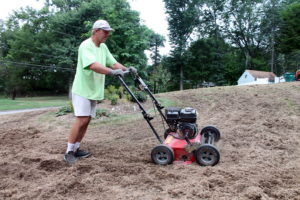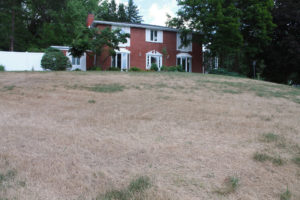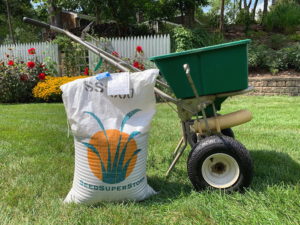Bringing Back My Zombie Lawn
September 14th, 2021
Last year at this time, I was laboring behind a heavy, gas-powered dethatching machine, tearing up the remnants of a dead front lawn.

Here I am digging up dead turf with a dethatching machine last September.
Nearly the entire quarter-acre of thatch-infested grass died following weeks of punishing late-summer heat and no rain.
I’d never lost that much grass before, and I had to reseed and water, water, water the whole wretched expanse.
My GreenView blend of Kentucky bluegrass, perennial ryegrass, and fine fescue came up nicely and looked reasonably good by late fall and into this spring.
But when summer heat returned, I ended up with a thin lawn infected with red-thread disease and outbreaks of crabgrass, nutsedge, and a host of broad-leaf weeds (oxalis, clover, plantain, dandelions, spotted spurge, etc.)
After a dry spell in August, my zombie lawn was looking sickly, brown, and weedy.
I thought I’d share what I’m planning to do next since 1.) these setbacks are fairly common when starting or replacing a lawn, and 2.) many of you no doubt have struggling lawns, too.
After all, this is the best time of year to do something about it all.
I should first mention that I’m not a lawn fanatic who’s shooting for that perfect green carpet.
I’m also not a fan of the big lawn I inherited. A quarter-acre of it is more than I would’ve wanted, and if I were 20 years younger, I’d be replacing the majority of it with garden beds so that the lawn served merely as the paths between the beds, as was the case at my previous Cumberland County home.
My new lawn in the Pittsburgh suburbs is a problem child for several reasons.
One is that the underlying soil is rock hard – a compacted, sluggish, blackish clay that looks like something on the way to becoming coal.
Another is that the lawn is on a busy traffic corner (asphalt on two sides) and has sloping east- and south-facing exposures.
That means it’s a site getting extra heat and hot summer breezes from the roads and cars and is getting maximum-sharp rays from the afternoon sun.
Those roadside perimeters also are getting road salt from winter plowing, which amplifies the effect of summer dryness on grass roots.
On top of that, the lawn has a history of neglect bordering on abuse – information I picked up from neighbors.
Earlier residents had installed an irrigation system, which while can keep grass green all summer and prevent the heat/drought-related death I experienced, also tends to encourage grass roots to stay close to the consistently damp surface.
If irrigation stops, those shallow grass roots aren’t well equipped to deal with drought.
That’s exactly what happened with the residents who sold us the house. They not only didn’t irrigate but didn’t fertilize, control weeds, or even mow regularly. The death of shallow roots is likely what contributed to the buildup of thatch in the lawn.
Neighbors told me the previous owners were cited by the borough at least twice for letting the lawn grow into a weedy jungle. They eventually hired out the mowing – but only every two weeks.
The result of that was a huge buildup of weed seeds (ones that are still sprouting years later) and a lawn stressed from biweekly whackbacks instead of lighter, more regular, and easier-healing weekly trims.

A big brown lawn is worse than a big green lawn.
I’m first trying to mitigate the heat effects with shade. One of my first changes was interspersing trees throughout the front yard – a sweetbay magnolia, a gingko, a dawn redwood, a Cornelian cherry dogwood, a ‘Wildfire’ black gum, a weeping purple-leaf beech, and a pair of American fringe trees.
These not only break up the sea of green, but they’ll eventually cool the yard, filter those south-facing rays, and reduce mowing as I plant low-care groundcovers under and around them.
I then tested the soil to get a handle on any adjustments needed in soil nutrition.
The pH came back just slightly acidic (a good reading, meaning no lime was needed) and high in phosphorus and potassium (nothing needed on those fronts either).
What the lawn mainly needs is nitrogen – the main nutrient that lawns chew up on a regular basis.
The fact that my lawn came down with red thread is also a sign that it’s short on nitrogen.
I already fertilized once in spring with a granular product rich in slow-release nitrogen, and I applied an organic fertilizer (Ringer Lawn Restore) after rains got the grass growing again in late August.
I’ll do one more treatment in late October or early November with Milorganite, another nitrogen-rich, granular, organic fertilizer made from Milwaukee treated sewage sludge. (It supposedly offers the side benefit of discouraging deer, which is another problem I face in Pittsburgh, especially in winter.)
The biggest help, though, is going to be overseeding the lawn with additional grass seed.

My bag of turf-type tall fescue seed is ready to go into the thin lawn.
This should thicken the lawn and reduce future weed problems since any open spots are invitations for weeds to occupy them.
Through mowing high, fertilizing as needed, and overseeding occasionally at my old place, I had a thick enough lawn that crabgrass and other weeds really weren’t a problem. In all my years there, I never used a crabgrass preventer or a “weed-and-feed” treatment.
Even with my new overseeding here, I’m planning to use a crabgrass preventer for the first time ever early next spring. Crabgrass sprouted all over this year, out-competing the “real” grass that was trying to gain a foothold from last year’s planting.
Crabgrass is difficult to control once it’s up and maturing, so I resorted to hand-pulling the worst of it. The rest will die with frost.
I broke down, though, and had to spot-spray herbicide on the many patches of broad-leaf weeds and nutsedge that also were quickly overtaking my young grass.
By dispatching as many of those as I could, space is now open for the new grass seed I’ll be putting down.
I’m renting a slit-seeder (sometimes called a “verticutter”) to help with the seeding job. This is another heavy gas-powered machine that cuts shallow vertical slits in the turf and then deposits seeds through little hoppers behind each cutting blade.
This is an efficient, one-step way to seed larger areas without having to resort to the more labor-intensive alternative of disturbing the soil and then raking and tamping the scattered seed into it.
I’ll still have to keep the ground consistently damp until the seed is up and growing, though.
To further counteract the heat and dryness of this site, I’m overseeding with turf-type tall fescue.
This is a type of grass that’s a little more coarse than bluegrass and perennial ryegrass, but the tradeoff is that it’s more durable in heat, drought, and foot traffic.
Tall fescues are a lot better-looking these days than the old Kentucky 31 variety, which is so coarse and clumpy that it doesn’t look much better than crabgrass or goosegrass.

My seed mix is a blend of four different highly rated turf-type tall fescue varieties.
To maximize success, I mail-ordered a blend of four top-rated tall-fescue varieties from the Seed Super Store in Buffalo.
Varieties of grass seed make a big difference, as you can see first-hand if you ever visit the turfgrass trial fields at Penn State University (or any turfgrass trial, for that matter).
Penn State and other researchers throughout the country compile their variety results through the website of the National Turfgrass Evaluation Program. Check out that website for top varieties of each kind of grass, and then seek out grass mixes that carry those varieties.
For more on choosing the best grass seed, check out my past column here.
Assuming my tall-fescue overseeding works, I hope to end up with fewer weed issues and a more diverse lawn that’s better equipped to tolerate the assorted challenges from bugs, diseases, weather, and lousy soil.
Next year, I’ll fertilize three times again and make my fall project one of core-aerating and top-dressing with compost (to slowly begin aiding the lousy-soil drawback).
But first, to the slit-seeder…
Read more in George’s post on How to Do Your Own Lawn Care







